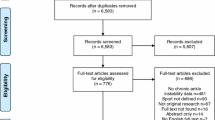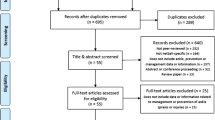Abstract
Background
Ankle bracing has been verified as being effective for secondary prevention of ankle injuries. However, new studies have recently been published that are not included in previous meta-analyses. Furthermore, the effects of bracing for primary prevention of ankle injuries are still unclear.
Objective
The objective of this article was to systematically review the literature about the effectiveness of ankle bracing on primary and secondary prevention of acute ankle injuries in athletes.
Methods
We searched PubMed, EMBASE, SPORTDiscus, CINAHL, and PEDro databases for eligible articles until July 2018. Randomized controlled trials that studied ankle bracing vs. no intervention for athletes were included. Risk of bias was assessed with the Cochrane Risk of Bias tool. Meta-analyses were conducted to study the effect of ankle bracing for primary and secondary prevention of ankle injuries. The Grading of Recommendation Assessment, Development, and Evaluation method was used to determine the quality of evidence.
Results
We included six randomized controlled trials. Significant risk ratios of 0.53 (95% confidence interval 0.32–0.88) and 0.37 (95% confidence interval 0.24–0.58) were found in favor of ankle bracing vs. no ankle bracing for primary (low quality of evidence, I2 = 77%) and secondary prevention (moderate quality of evidence, I2 = 0%) of acute ankle injuries. Numbers needed to treat were 26 and 12 for the primary and secondary prevention of acute ankle injuries.
Conclusions
Ankle bracing is effective for primary and secondary prevention of acute ankle injuries among athletes. However, conclusions in regard to primary prevention should be drawn cautiously because of the low quality of evidence and significant heterogeneity.




Similar content being viewed by others
References
Doherty C, Delahunt E, Caulfield B, Hertel J, Ryan J, Bleakley C. The incidence and prevalence of ankle sprain injury: a systematic review and meta-analysis of prospective epidemiological studies. Sports Med. 2014;44:123–40.
Fong D, Hong Y, Chan L, Yung P, Chan K. A systematic review on ankle injury and ankle sprain in sports. Sports Med. 2007;37(1):73–94.
Hootman JM, Dick R, Agel J. Epidemiology of collegiate injuries for 15 sports: summary and recommendations for injury prevention initiatives. J Athl Train. 2007;42(2):311–9.
Waterman CBR, Owens MBD, Davey CS, Zacchilli CMA, Belmont LC. The epidemiology of ankle sprains in the United States. J Bone Jt Surg Am. 2010;92(13):2279–84.
Kemler E, van de Port I, Backx F, van Dijk CN. A systematic review on the treatment of acute ankle sprain: brace versus other functional treatment types. Sports Med. 2011;41(3):185–97.
Veiligheid NL. Enkelblessures, ongevalscijfers. 2014. https://www.veiligheid.nl/sportblessures/kennis/cijfers-over-sportblessures. Accessed 1 Oct 2018.
Kemler E, Thijs KM, Badenbroek I, van de Port IGL, Hoes AW, Backx FJG. Long-term prognosis of acute lateral ankle ligamentous sprains: high incidence of recurrences and residual symptoms. Fam Pract. 2016;33(6):596–600.
van Rijn RM, van Os AG, Bernsen RMD, Luijsterburg PA, Koes BW, Bierma-Zeinstra SMA. What is the clinical course of acute ankle sprains? A systematic literature review. Am J Med. 2008;121(4):324–331.e7.
Gross P, Marti B. Risk of degenerative ankle joint disease in volleyball players: study of former elite athletes. Int J Sports Med. 1999;20(1):58–63.
Handoll H, Rowe BH, Quinn KM, de Bie R. Interventions for preventing ankle ligament injuries. Cochrane Database Syst Rev. 2001;3:CD000018.
Dizon JMR, Reyes JJB. A systematic review on the effectiveness of external ankle supports in the prevention of inversion ankle sprains among elite and recreational players. J Sci Med Sport. 2010;13(3):309–17.
Yeung MS, Chan KM, So CH, Yuan WY. An epidemiological survey on ankle sprain. Br J Sports Med. 1994;28(2):112–6.
Institute for Work and Health. What researchers mean by primary, secondary, and tertiary prevention. At Work. Issue 80, Spring 2015. https://www.iwh.on.ca/sites/iwh/files/iwh/at-work/at_work_80_0.pdf. Accessed 1 Oct 2018.
Liberati A, Altman DG, Tetzlaff J, Mulrow C, Gøtzsche PC, Ioannidis JPA, et al. The PRISMA statement for reporting systematic reviews and meta-analyses of studies that evaluate health care interventions: explanation and elaboration. PLoS Med. 2009;6(7):e1000100.
Higgins J, Green S. Cochrane handbook for systematic reviews of interventions. Version 5.1.0. The Cochrane Collaboration. 2011. http://www.handbook.cochrane.org. Accessed 1 Oct 2018.
Verhagen EA, Bay K. Optimising ankle sprain prevention: a critical review and practical appraisal of the literature. Br J Sports Med. 2010;44(15):1082–8.
Landis JR, Koch GG. The measurement of observer agreement for categorical data. Biometrics. 2008;33(1):159–74.
Surve I, Schwellnus MP, Noakes T, Lombard C. A fivefold reduction in the incidence of recurrent ankle sprains in soccer players using the sport-stirrup orthosis. Am J Sports Med. 1994;22(5):601–6.
Mohammadi F. Comparison of 3 preventive methods to reduce the recurrence of ankle inversion sprains in male soccer players. Am J Sports Med. 2007;35(6):922–6.
Frey C, Feder KS, Sleight J. Prophylactic ankle brace use in high school volleyball players: a prospective study. Foot Ankle Int. 2010;31(4):296–300.
McGuine T, Brooks M, Hetzel S. The effect of lace-up ankle braces on injury rates in high school basketball players. Am J Sports Med. 2011;39(9):1840–8.
McGuine TA, Hetzel S, Wilson J, Brooks A. The effect of lace-up ankle braces on injury rates in high school football players. Am J Sports Med. 2012;40(1):49–57.
Sitler M, Ryan J, Wheeler B, McBride J, Arciero R, Anderson J, et al. The efficacy of a semirigid ankle stabilizer to reduce acute ankle injuries in basketball: a randomized clinical study at West Point. Am J Sports Med. 1994;22(4):454–61.
Schiftan GS, Ross LA, Hahne AJ. The effectiveness of proprioceptive training in preventing ankle sprains in sporting populations: a systematic review and meta-analysis. J Sci Med Sport. 2015;18(3):238–44.
Janssen KW, van Mechelen W, Verhagen EA. Bracing superior to neuromuscular training for the prevention of self-reported recurrent ankle sprains: a three-arm randomised controlled trial. Br J Sports Med. 2014;48(16):1235–9.
Verhagen EA, van der Beek AJ, van Mechelen W. The effect of tape, braces and shoes on ankle range of motion. Sports Med. 2001;31(9):667–77.
Mickel TJ, Bottoni CR, Tsuji G, Chang K, Baum L, Tokushige KAS. Prophylactic bracing versus taping for the prevention of ankle sprains in high school athletes: a prospective, randomized trial. J Foot Ankle Surg. 2006;45(6):360–5.
Kemler E, Krist MR, van de Port IGL, Hoes AW, Ardine de Wit G, Backx FJG. Economic evaluation of a soft ankle brace compared to tape in acute lateral ankle ligamentous sprains. Clin Res Foot Ankle. 2016;4:212. https://doi.org/10.4172/2329-910X.1000212.
Janssen K, Van Den Berg A, Van Mechelen W, Verhagen E. User survey of 3 ankle braces in soccer, volleyball, and running: which brace fits best? J Athl Train. 2017;52(8):730–7.
Reeser JC, Gregory A, Berg RL, Comstock RD. A comparison of women’s collegiate and girls’ high school volleyball injury data collected prospectively over a 4-year period. Sports Health. 2015;7(6):504–10.
Bahr R, Bahr IA. Incidence of acute volleyball injuries: a prospective cohort study of injury mechanisms and risk factors. Scand J Med Sci Sports. 1997;7(3):166–71.
Author information
Authors and Affiliations
Corresponding author
Ethics declarations
Funding
No sources of funding were used to assist in the preparation of this article.
Conflict of interest
Ingrid Barelds, Anke van den Broek, and Bionka Huisstede have no conflicts of interest that are directly relevant to the contents of this article.
Data availability
The datasets generated during and/or analyzed during the current study are available from the corresponding author on reasonable request.
Electronic supplementary material
Below is the link to the electronic supplementary material.
Rights and permissions
About this article
Cite this article
Barelds, I., van den Broek, A.G. & Huisstede, B.M.A. Ankle Bracing is Effective for Primary and Secondary Prevention of Acute Ankle Injuries in Athletes: A Systematic Review and Meta-Analyses. Sports Med 48, 2775–2784 (2018). https://doi.org/10.1007/s40279-018-0993-2
Published:
Issue Date:
DOI: https://doi.org/10.1007/s40279-018-0993-2




